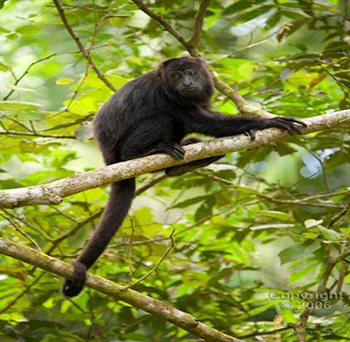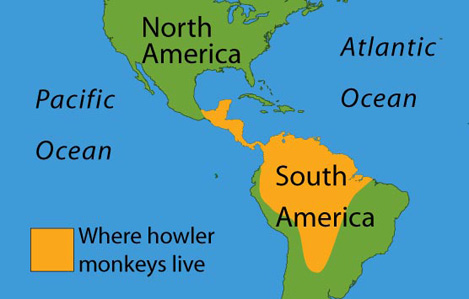Black Howler Monkey
Alouatta pigra

Taxonomy:
Kingdom: Animalia
Phylum: Chordata
Class: Mammalia
Order: Primates
Family: Atelidae
Subfamily: Alouattinae
Genus: Alouatta
Life History:
Alouatta pigra is commonly known as the Black Howler Monkey and is within the family Atelidae. The howler monkey is also known as the "baboon" in Belize, and it is the largest monkey in Belize and one of the largest in the Americas (Adventure Life (Authentic Travel). Atelidae is part of the Platyrrhini, which consists of the New World Monkeys. Within the Atelidae family, other monkeys such as the Spider Monkey (which is also found in Belize) and the Wooly Monkeys are found.
Geographical Location:
The howler monkeys’ habit includes a wide variety of forest types from mangroves to cloud forests, from southern Mexico to northern Argentina (Terry A. Vaughan, 2011). The environment that howler monkeys are typically found in is rainforest settings.

Ecology:
Some of the defining characteristics of the Black Howler Monkey are the long, prehensile tails which are used in their arboreal lifestyles. The limbs of the monkeys are long and slender, which is a major advantage when moving from tree to tree. Associated with the hands, digits one and two on each hand are separates from and opposable to the remaining digits (Terry A. Vaughan, 2011). When moving from tree to tree, the monkey has a quadrupedally locomotion. The fur is long and coarse and ranges from a light brown to a black color, depending on the species being observed. The Black Howler Monkey is considered a diurnal animal, which simply means being active during the day time. With being a herbivore, the Black Howler Monkey moves through the canopy in search for leaves, fruits and flowers (Terry A. Vaughan, 2011). Also, the Black Howler Monkey is known for extremely loud calls. The calls are produced by the hyoid resonating chamber found in the throats of the mammal. These sounds seem important in maintaining the cohesiveness of the troop and protection of territories (Terry A. Vaughan, 2011).
Behavior and Reproduction:
The sociality of the Black Howler Monkey is considered well-developed. This monkey tends to live in troops up to 45 members. In most species of the Atelidae, males are philopatric (tending to stay in their natal area), and females disperse to join new groups when they reach adolescence at usually 5 to 7 years (Terry A. Vaughan, 2011). The reproduction rate of the typical howler monkey is usually one young per gestation period. The gestation period is approximately 180 days for most species of howlers. The females are the main care providers of the young and usually continue to taken care of the offspring until they reach the age of one or when the young can defend and provide for themselves. The males do not provide any parental care whatsoever. Also, some species of older males within the Alouatta commit infanticide when young males newly enter the group or when the male dominance hierarchy is reshuffled (Terry A. Vaughan, 2011).
Economic/Ecological Service:
The most important ecological service that Black Howler Monkeys do is transport seed through fecal material and through the fur. As the monkeys move through the trees, it is very likely for seeds of some plants to become tangled within the fur. This allows the seed to be transported to great distances from the parent plant.
The Black Howler Monkey is a herbivore, meaning they eat a lot of plant material such as fruit. The fruit contains seeds and when eaten can become part of the fecal material. With the rainforest being so dense with vegetation, it is vital that the parent plant disperse the seeds away from them to decrease plant competition and increase the likelihood of that seed becoming a mature plant.
From an economic stand point, the Black Howler Monkey serves as a great tourist attraction and an interesting research project. With more people either coming to view the Black Howler Monkey for a summer adventure or a major research project, money that they spend within the local community will help boost economical situations.
Recent Research:
One research report published in 2010 was the “Black and Gold Howler Monkeys (Alouatta caraya) as Sentinels of Ecosystem Health: Patterns of Zoonotic Protozoa Infection Relative to Degree of Human–Primate Contact." The purpose of this report was basically to understand the different effects of human impact on the howler monkeys. Interestingly, what was discovered through fecal samples is a pathogen that is not a natural component of the howler parasite communities and that current land-use patterns and livestock contact are not exposing Argentine howler monkeys to this pathogen (KOWALEWSKI, 2010). Conclusively, human contact has no pathogenic impact on the howler monkeys.
In 2004, a report was published over the study of the loud calls with which the Black Howler Monkey is associated. The report was called “Subordinate Male Black Howler Monkey (Alouatta pigra) Response to Loud Calls: Experimental Evidence for the Effects of Intra-Group Male Relationships and Age." The results determined that subordinate males in long-term alpha-subordinate associations had stronger howling and approach responses than males in short-term associations. Younger long-term associates had the strongest reactions to simulated intruders, similarly aged short-term associates rarely responded and older males in both association categories responded at intermediate levels (DAWN M. KITCHEN, 2004).
Personal Interests:
I have always been fascinated with the different types of monkey. When taking a Mammalogy class at Lamar University this spring, I was very interested with both the New World and Old World monkeys. When given the opportunity to create a web page over a terrestrial animal that is found in Belize, the howler monkey was first on my list. This project gave me the opportunity to expand my education on the howler monkey.
Suggested Sites:
Smithsonian National Zoological Park
Rainforest Alliance
References:
Please note that the following references may have either been removed or relocated by the webpage owners since the time this student report was created.
- “Picture of Black Howler Monkey” Images of Belize, http://farm1.static.flickr.com/140/422058602_5381998b7a.jpg
- Adventure Life (Authentic Travel). (n.d.). Retrieved from http://www.adventure-life.com/articles/howler-monkeys-115/
- Dawn M.Kitchen, R. H. (2004). Subordinate Male Black Howler Monkey (ALOUATTA.
- Kowalewski, M. M. (2010). Black and Gold Howler Monkeys (Alouatta caraya) as Sentinels of Ecosystem.
- Terry A. Vaughan, R. a. (2011). Mammalogy . In T. A. Vaughan. Sudbury, Massachusetts: Jones and Bartlett Publishers.